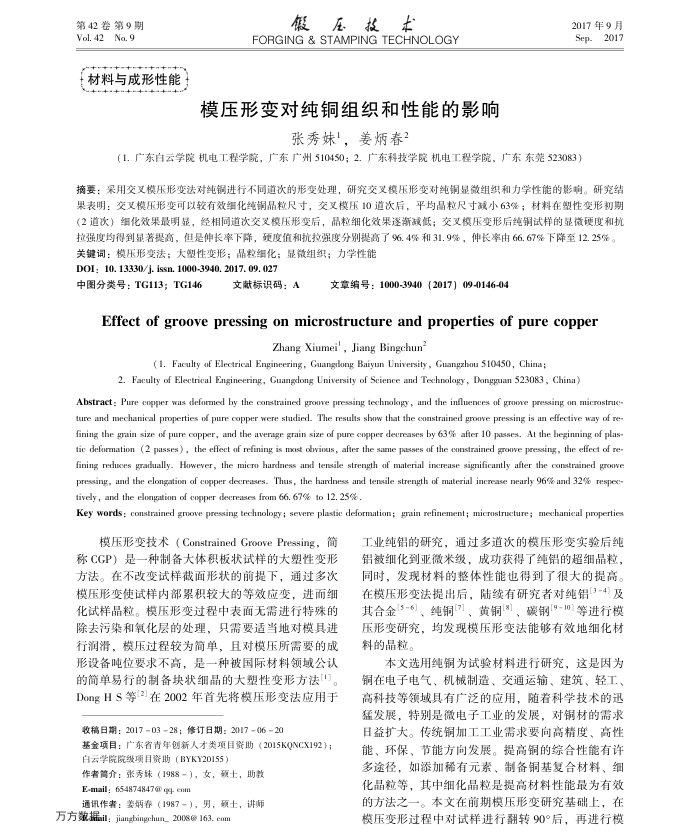您当前的位置:首页>论文资料>模压形变对纯铜组织和性能的影响
内容简介
 第42卷第9期 Vol. 42No. 9
第42卷第9期 Vol. 42No. 9材料与成形性能
假压技木
FORGING & STAMPING TECHNOLOGY
模压形变对纯铜组织和性能的影响
张秀妹',姜炳春2
2017年9月 Sep-2017
(1.广东白云学院机电工程学院,广东广州510450;2.广东科技学院机电工程学院,广东东莞523083)
摘要:采用交叉模压形变法对纯铜进行不同道次的形变处理,研究交叉模压形变对纯铜显微组织和力学性能的影响。研究结果表明:交叉模压形变可以较有效细化纯铜晶粒尺寸,交叉模压10道次后,平均晶粒尺寸减小63%;材料在塑性变形初期(2道次)细化效果最明显,经相同道次交叉模压形变后,晶粒细化效果逐渐减低;交艾模压变形后纯铜试样的显微硬度和抗拉强度均得到显著提高,但是伸长率下降,硬度值和抗拉强度分别提高了96.4%和31.9%,伸长率由66.67%下降至12.25%。
关键词:模压形变法;大塑性变形;晶粒细化;显微组织;力学性能 DOI: 10. 13330/j. issn. 1000-3940. 2017. 09, 027
中图分类号:TG113;TG146
文献标识码:A
文章编号:1000-3940(2017)09-0146-04
Effect of groovepressing onmicrostructure andproperties ofpure copper
Zhang Xiumei', Jiang Bingchun?
(1. Faculty of Electrical Engineering, Guangdong Baiyun University , Guangzhou 510450, China ;
2. Faculty of Electrical Engineering, Guangdong University of Seience and Technology , Dongguan 523083 , China)
Abstract : Pure copper was deformed by the constrained groove pressing technology , and the influences of groove pressing on microstruc-ture and mechanical properties of pure copper were studied. The results show that the constrained groove pressing is an effective way of re-fining the grain size of pure copper, and the average grain size of pure copper decreases by 63% after 10 psses. At the beginning of plas-tic deformation (2 passes ) , the effect of refining is most obvious, after the same passes of the constrained groove pressing, the effect of re-fining reduces gradually. However, the micro hardness and tensile strength of material increase significantly after the constrained groove pressing, and the elongation of copper decreases. Thus, the hardness and tensile strength of material increase nearly 96% and 32% respec-tively, and the elongation of copper decreases from 66. 67% to 12. 25%,
Key words : constrained groove pressing technology; severe plastic deformation; grain refinement; microstructure; mechanical properties
模压形变技术(Constrained GroovePressing,简称CGP)是一种制备大体积板状试样的大塑性变形方法。在不改变试样截面形状的前提下,通过多次模压形变使试样内部累积较大的等效应变,进而细化试样晶粒。模压形变过程中表面无需进行特殊的除去污染和氧化层的处理,只需要适当地对模具进行润滑,模压过程较为简单,且对模压所需要的成形设备吨位要求不高,是一种被国际材料领域公认的简单易行的制备块状细晶的大塑性变形方法1]。 DongHS等[2]在2002年首先将模压形变法应用于
收稿日期:20170328;修订日期:20170620
基金项目:广东省青年创新人才类项目资助(2015KQNCX192);白云学院院级项目资助(BYKY20155)
作者筒介:张秀妹(1988-),女,颈士,助教 E-mail: 654874847@ q com
通讯作者:姜炳春(198了-),男,颈士,讲师万方数据ail:janghingchun_2008@163.com
工业纯铝的研究,通过多道次的模压形变实验后纯铝被细化到亚微米级,成功获得了纯铝的超细晶粒,同时,发现材料的整体性能也得到了很大的提高。在模压形变法提出后,陆续有研究者对纯铝[3-4]及其合金(5-6]、纯铜[7]、黄铜[8]、碳钢[9-10]等进行模压形变研究,均发现模压形变法能够有效地细化材料的晶粒。
本文选用纯铜为试验材料进行研究,这是因为铜在电子电气、机械制造、交通运输、建筑、轻工、高科技等领域具有广泛的应用,随着科学技术的迅猛发展,特别是微电子工业的发展,对铜材的需求日益扩大。传统铜加工工业需求要向高精度、高性能、环保、节能方间发展。提高铜的综合性能有许多途径,如添加稀有元素、制备铜基复合材料、细化晶粒等,其中细化晶粒是提高材料性能最为有效的方法之一。本文在前期模压形变研究基础上,在模压变形过程中对试样进行翻转90°后,再进行模